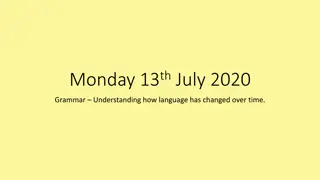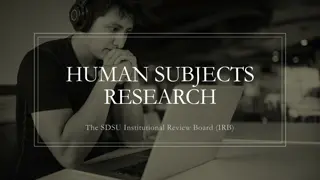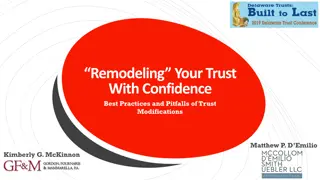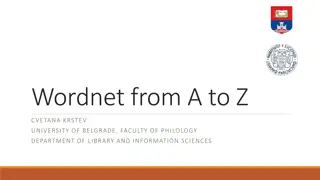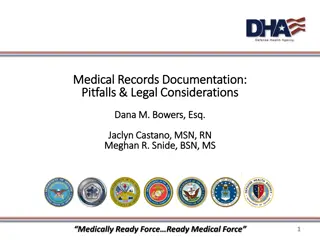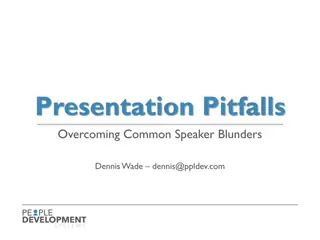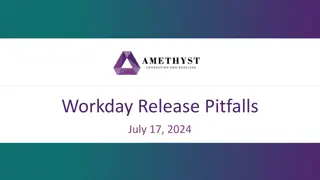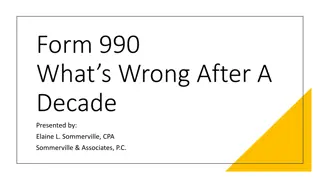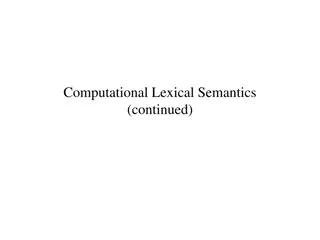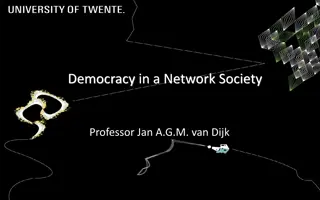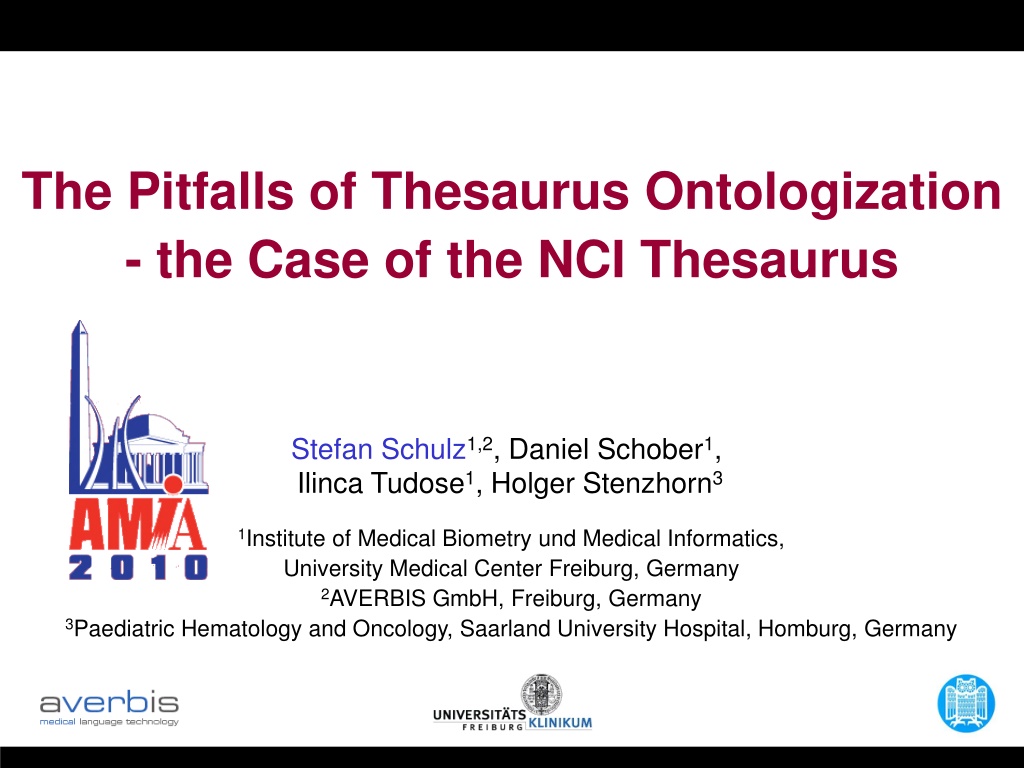
The Pitfalls of Thesaurus Ontologization in NCI Thesaurus Case
Explore the challenges of upgrading a thesaurus to a formal ontology, including issues of ambiguity and non-universal statements. Learn about the differences between expressiveness in thesauri and ontologies, and the complexities of translating thesaurus triples into ontology axioms.
Download Presentation

Please find below an Image/Link to download the presentation.
The content on the website is provided AS IS for your information and personal use only. It may not be sold, licensed, or shared on other websites without obtaining consent from the author. Download presentation by click this link. If you encounter any issues during the download, it is possible that the publisher has removed the file from their server.
E N D
Presentation Transcript
The Pitfalls of Thesaurus Ontologization - the Case of the NCI Thesaurus Stefan Schulz1,2, Daniel Schober1, Ilinca Tudose1, Holger Stenzhorn3 1Institute of Medical Biometry und Medical Informatics, University Medical Center Freiburg, Germany 2AVERBIS GmbH, Freiburg, Germany 3Paediatric Hematology and Oncology, Saarland University Hospital, Homburg, Germany http://www.averbis.de
Background Methods Results Discussion Conclusions Typology Informal Thesauri Formal ontologies Examples: openGALEN, OBO, SNOMED Describe entities of a domain Classes: collection of entities according to their properties Axioms state what is universally true for all members of a class Logical expressions: C1 comp rel quant C2 Examples: MeSH, UMLS Metathesaurus, WordNet Describe terms of a domain Concepts: represent the meaning of (quasi-) synonymous terms Concepts related by (informal) semantic relations Linkage of concepts: C1 Rel C2
Background Methods Results Discussion Conclusions Thesaurus ontologization Upgrading a thesaurus to a formal ontology Rationales: use of standards (e.g. OWL-DL), enhanced reasoning, clarification of meaning, internal quality assurance Expressiveness of thesauri vs. ontologies: The meaning of thesaurus assertions follows natural language, the meaning of ontology axioms follow mathematical rigor Thesaurus triples cannot be unambiguously translated into ontology axioms C1 Rel C2 C1 comp rel quant C2 ?
Background Methods Results Discussion Conclusions Problem 1: Ambiguity C1 subClassOf rel some C2 or Translation of triples C1 subClassOf rel only C2 or C1 Rel C2 C2 subclassOf inv(rel) some C2 or Translation of groups of triples C1 subClassOf (rel some C2) and (rel some C3) or C1 Rel C2 C1 equivalentTo (rel some C2) and (rel some C3) or C1 Rel C3 C1 equivalentTo (rel some C2 or C3) or
Background Methods Results Discussion Conclusions Problem 2: Non-universal statements Aspirin Treats Headache Headache Treated-by Aspirin (seemingly intuitively understandable) Translation problem into ontology: Not every aspirin tablet treats some headache Not every headache is treated by some aspirin Description logics do not allow probabilistic, default, or normative assertions Axioms can only state what is true for all members of a class
Background Methods Results Discussion Conclusions Objective of the study
Background Methods Results Discussion Conclusions Objective of the study Investigate correctness of existentially quantified properties in biomedical ontologies OBO Foundry ontologies OBO Foundry candidates NCIT as an instance of OBO Foundry candidates Selection of NCIT Size System in use Importance for generating and communicating standardized meanings in oncology Quality issues already addressed by Ceusters W, Smith B, Goldberg L. A terminological and ontological analysis of the NCI Thesaurus. Methods of Information in Medicine 2005;44(4):498-507.
Background Methods Results Discussion Conclusions Assessment Method (I) Select a sample of existentially quantified clauses from the NCIT OWL version Pattern: C1 subClassOf rel some C2, according to description logics semantics : Every instance of C1 is related to at least one instance of C2 via the relation rel Found: 77 different relation types, used in more than 180,000 existentially qualified clauses Most frequent relation Disease_may_have_finding (N = 27,653) 15 relation types occurring less than ten times each. Sampling: ni= round (2 log10(Ni+1)) with Nibeing the number of existentially qualified restrictions in which riwas used
Background Methods Results Discussion Conclusions Assessment Method (II) Each sample expression like C1 subClassOf Rel some C2 was assessed by two experts for correctness Assessment Criteria: Ontological commitment: the NCIT classes extend to real things in the clinical domain Focus: to judge whether the ontological dependence of C1 on C2 is adequate Exact confidence intervals (95%) were computed based on the binomial distribution. Also collected: anecdotic evidence of other kinds of errors.
Background Methods Results Discussion Conclusions Results
NCIT relation type # occurrences in OWL "someValues From" clause sam- ple size # errors in sample sample error rate estimated number of errors 95% CI lower bound 95% CI upper bound 95% CI estimate lower bound 95% CI estimate upper bound Disease_May_Have_Finding Disease_May_Have_Cytogenetic_Abnormality Gene_Product_Plays_Role_In_Biological_Process Gene_Plays_Role_In_Process Chemotherapy_Regimen_Has_Component Gene_Product_Encoded_By_Gene Disease_May_Have_Molecular_Abnormality Gene_Is_Element_In_Pathway Gene_Product_Is_Element_In_Pathway Gene_Product_Has_Biochemical_Function Anatomic_Structure_Is_Physical_Part_Of Gene_In_Chromosomal_Location Gene_Found_In_Organism Disease_May_Have_Associated_Disease EO_Disease_Has_Associated_EO_Anatomy Gene_Has_Physical_Location Gene_Product_Expressed_In_Tissue Disease_May_Have_Abnormal_Cell Gene_Product_Has_Associated_Anatomy Gene_Product_Has_Organism_Source Chemical_Or_Drug_Has_Physiologic_Effect EO_Disease_Maps_To_Human_Disease Gene_Associated_With_Disease Gene_Product_Has_Structural_Domain_Or_Motif Chemical_Or_Drug_Has_Mechanism_Of_Action Gene_Product_Malfunction_Associated_With_Disease OTHER RELATIONS SUM 27,652 18,860 15,607 14,385 10,861 10,754 10,687 8,364 8,302 7,695 6,285 5,392 4,086 3,353 3,102 2,945 2,476 2,442 1,972 1,904 1,818 1,811 1,581 1,329 1,094 1,049 6,494 182,300 9 9 8 8 8 8 8 8 8 8 8 7 7 7 7 7 7 7 7 7 7 7 6 6 6 6 9 9 8 8 0 0 7 8 8 0 1 0 0 7 0 0 7 7 1 0 7 7 3 0 6 6 1.00 1.00 1.00 1.00 0.00 0.00 0.88 1.00 1.00 0.00 0.13 0.00 0.00 1.00 0.00 0.00 1.00 1.00 0.14 0.00 1.00 1.00 0.50 0.00 1.00 1.00 0.41 27,652 18,860 15,607 14,385 0.66 0.66 0.63 0.63 0.00 0.00 0.47 0.63 0.63 0.00 0.00 0.00 0.00 0.59 0.00 0.00 0.59 0.59 0.00 0.00 0.59 0.59 0.12 0.00 0.54 0.54 0.34 1.00 1.00 1.00 1.00 0.37 0.37 1.00 1.00 1.00 0.37 0.53 0.41 0.41 1.00 0.41 0.41 1.00 1.00 0.58 0.41 1.00 1.00 0.88 0.46 1.00 1.00 0.49 18,353 12,517 9,842 9,071 27,652 18,860 15,607 14,385 4,012 3,973 10,653 8,364 8,302 2,843 3,309 2,209 1,674 3,353 1,271 1,206 2,476 2,442 1,141 780 1,818 1,811 1,394 610 1,094 1,049 3,168 145,455 0 0 31 30 9,351 8,364 8,302 5,060 5,274 5,235 0 22 20 0 0 786 0 0 3,353 1,980 0 0 0 0 2,476 2,442 282 1,462 1,442 7 0 0 1,818 1,811 791 1,073 1,069 187 0 0 1,094 1,049 2,669 121,091 592 567 163 354 67 176 2,197 76,031
NCIT relation type # occurrences in OWL "someValues From" clause sam- ple size # errors in sample sample error rate estimated number of errors 95% CI lower bound 95% CI upper bound 95% CI estimate lower bound 95% CI estimate upper bound Disease_May_Have_Finding Disease_May_Have_Cytogenetic_Abnormality Gene_Product_Plays_Role_In_Biological_Process Gene_Plays_Role_In_Process Chemotherapy_Regimen_Has_Component Gene_Product_Encoded_By_Gene Disease_May_Have_Molecular_Abnormality Gene_Is_Element_In_Pathway Gene_Product_Is_Element_In_Pathway Gene_Product_Has_Biochemical_Function Anatomic_Structure_Is_Physical_Part_Of Gene_In_Chromosomal_Location Gene_Found_In_Organism Disease_May_Have_Associated_Disease EO_Disease_Has_Associated_EO_Anatomy Gene_Has_Physical_Location Gene_Product_Expressed_In_Tissue Disease_May_Have_Abnormal_Cell Gene_Product_Has_Associated_Anatomy Gene_Product_Has_Organism_Source Chemical_Or_Drug_Has_Physiologic_Effect EO_Disease_Maps_To_Human_Disease Gene_Associated_With_Disease Gene_Product_Has_Structural_Domain_Or_Motif Chemical_Or_Drug_Has_Mechanism_Of_Action Gene_Product_Malfunction_Associated_With_Disease OTHER RELATIONS SUM 27,652 18,860 15,607 14,385 10,861 10,754 10,687 8,364 8,302 7,695 6,285 5,392 4,086 3,353 3,102 2,945 2,476 2,442 1,972 1,904 1,818 1,811 1,581 1,329 1,094 1,049 6,494 182,300 9 9 8 8 8 8 8 8 8 8 8 7 7 7 7 7 7 7 7 7 7 7 6 6 6 6 9 9 8 8 0 0 7 8 8 0 1 0 0 7 0 0 7 7 1 0 7 7 3 0 6 6 1.00 1.00 1.00 1.00 0.00 0.00 0.88 1.00 1.00 0.00 0.13 0.00 0.00 1.00 0.00 0.00 1.00 1.00 0.14 0.00 1.00 1.00 0.50 0.00 1.00 1.00 0.41 27,652 18,860 15,607 14,385 0.66 0.66 0.63 0.63 0.00 0.00 0.47 0.63 0.63 0.00 0.00 0.00 0.00 0.59 0.00 0.00 0.59 0.59 0.00 0.00 0.59 0.59 0.12 0.00 0.54 0.54 0.34 1.00 1.00 1.00 1.00 0.37 0.37 1.00 1.00 1.00 0.37 0.53 0.41 0.41 1.00 0.41 0.41 1.00 1.00 0.58 0.41 1.00 1.00 0.88 0.46 1.00 1.00 0.49 18,353 12,517 9,842 9,071 27,652 18,860 15,607 14,385 4,012 3,973 10,653 8,364 8,302 2,843 3,309 2,209 1,674 3,353 1,271 1,206 2,476 2,442 1,141 780 1,818 1,811 1,394 610 1,094 1,049 3,168 145,455 0 0 31 30 9,351 8,364 8,302 5,060 5,274 5,235 0 22 20 0 0 786 0 0 3,353 1,980 0 0 0 0 2,476 2,442 282 1,462 1,442 7 0 0 1,818 1,811 791 1,073 1,069 187 0 0 1,094 1,049 2,669 121,091 592 567 163 354 67 176 2,197 76,031
Background Methods Results Discussion Conclusions Results Very high rate of ontologically inadequate axioms: Half of the sample: n = 176 rated as inadequate Estimation 0.5 [0.42 0.80]95% inter-rater agreement (Cohen s Kappa): 0.75 [0.68 0.82]95% Typical inadequate statements 1. relations including may (disease_may_have_finding) 2. relations including role (gene_product_plays_role_in_process) inverse dependencies (e.g. parts on wholes) 3. 4. distributive assertions formulated as conjunctions
Background Methods Results Discussion Conclusions Why are they rated false? Ureter_Small_Cell_Carcinoma subclassOf Disease_May_Have_Finding some Pain in plain English: For every member of the class Ureter_Small_Cell_Carcinoma there is a relation to at least one member of the class Pain (regardless of the nature of the relation) Let us abstract the relation Disease_May_Have_Finding to the parent relation Associated_With (the top of the relation hierarchy): With Ureter_Small_Cell_Carcinoma subclassOf Carcinoma, a query for painless cancer: Carcinoma and not Associated_With some Pain will not retrieve any disease case classified as Ureter_Small_Cell_Carcinoma A DSS using NCIT-OWL + reasoner could then fatally infer that the absence of pain rules out the diagnosis Ureter_Small_Cell_Carcinoma
Background Methods Results Discussion Conclusions What is the basic problem? Mismatch between the intended meaning of a relation, here the notion of may in Disease_May_Have_Finding the set-theoretic interpretation of the quantifier some in Description Logics Problem: DLs have no in-built operator for expressing possibility Solution (Workaround ?): dispositions with value restrictions: Ureter_Small_Cell_Carcinoma subclassOf Bearer_of some (Disposition and Has_Realization only Pain)
Background Methods Results Discussion Conclusions Other errors and possible solutions (I) Antibody_Producing_Cell subclassOf Part_Of some Lymphoid_Tissue Problem: Cells produce antibodies also outside the lymphoid tissue Solution: Inversion: Lymphoid_Tissue subclassOf Has_Part some Antibody_Producing_Cell (which is NOT the same as the above axiom)
Background Methods Results Discussion Conclusions Other errors and possible solutions (II) Calcium-Activated_Chloride_Channel-2 subClassOf Gene_Product_Expressed_In_Tissue some Lung and Gene_Product_Expressed_In_Tissue some Mammary_Gland and Gene_Product_Expressed_In_Tissue some Trachea Problem: False encoding of distributive statements (a single molecule cannot be located in disjoint locations) Solution (but probably not complete ): Calcium-Activated_Chloride_Channel-2 subClassOf Gene_Product_Expressed_In_Tissue only (Lung_Structure or Mammary_Gland _Structure or Trachea_Structure)
Background Methods Results Discussion Conclusions Discussion Obviously, NCIT-OWL if strictly interpreted according OWL semantics, abounds of errors NCIT curators: much more ( ) a working terminology than as a pure ontology de Coronado S et al. The NCI Thesaurus Quality Assurance Life Cycle. Journal of Biomedical Informatics 2009 Jan 22. But then why is it disseminated in OWL? If interpreted according to OWL semantics, systems using logical inference on NCIT axioms might become unreliable
Background Methods Results Discussion Conclusions Conclusion (beyond NCIT) Main problem of thesaurus ontologization: term / concept representation reality representation Consequences labor-intensive if done manually error-prone if done automatically Recommendations don t OWLize a thesaurus it if there is no clear use case use other Semantic Web standard, e.g. SKOS in case there is a good reason for transforming to a formal ontology, - use a principled ontology engineering approach - use categories and relations from an upper-level ontology - invest in quality assurance measures
Thanks Schulz et al.: The Pitfalls of Thesaurus Ontologization - the Case of the NCI Thesaurus Contact: steschu@gmail.com Funding: EC project DebugIT (FP7-217139) Thanks to reviewers who provided high quality and detailed recommendations





